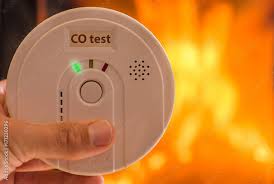The Importance of a Fire Alarm CO2 Detector
Fire safety is a critical concern for any property, whether it’s a home, office, or public building. One essential component of fire safety is early detection of potential hazards, such as the presence of carbon monoxide (CO) gas.
A fire alarm CO2 detector is a device specifically designed to detect the presence of carbon monoxide in the air. Carbon monoxide is a colourless, odourless gas that can be produced by incomplete combustion of fuels such as gas, oil, wood, and coal. Exposure to high levels of carbon monoxide can be extremely dangerous and even fatal.
Installing a fire alarm CO2 detector in your property can provide early warning of any potential carbon monoxide leaks, allowing you to take prompt action to protect yourself and others. These detectors are designed to sound an alarm when they detect elevated levels of carbon monoxide in the air, alerting occupants to evacuate the premises immediately and contact emergency services.
It’s important to place fire alarm CO2 detectors in key locations throughout your property, such as near bedrooms and common areas where people spend most of their time. Regular maintenance and testing of these detectors are also crucial to ensure they are functioning properly and providing reliable protection.
By investing in a fire alarm CO2 detector, you are taking a proactive step towards safeguarding your property and the people inside it from the dangers of carbon monoxide poisoning. Remember that early detection can make all the difference in preventing serious harm or loss of life in the event of a carbon monoxide leak.
Don’t wait until it’s too late – make sure you have a reliable fire alarm CO2 detector installed in your property today for peace of mind and enhanced safety.
Understanding Fire Alarm Systems: Distinguishing CO and CO2 Detectors, Detection Capabilities, and Alarm Thresholds
- What is the difference between CO alarm and CO2 alarm?
- Is a CO2 detector a fire alarm?
- What does a CO2 detector detect?
- What are alarm levels for CO2?
What is the difference between CO alarm and CO2 alarm?
When it comes to fire safety, understanding the distinction between a CO alarm and a CO2 alarm is crucial. A CO alarm, short for carbon monoxide alarm, is designed to detect the presence of carbon monoxide gas, which is a toxic byproduct of incomplete combustion. On the other hand, a CO2 alarm, or carbon dioxide alarm, is intended to monitor levels of carbon dioxide in the air, which can indicate poor ventilation or excessive occupancy in an enclosed space. While both gases can pose health risks in high concentrations, it’s important to note that they are different substances with distinct monitoring requirements. Therefore, having both types of alarms installed in appropriate areas of your property can provide comprehensive protection against potential hazards related to these gases.
Is a CO2 detector a fire alarm?
A common question that arises is whether a CO2 detector is the same as a fire alarm. It’s important to clarify that a CO2 detector and a fire alarm serve different purposes. A CO2 detector specifically detects the presence of carbon monoxide gas, which is a silent and potentially deadly threat in indoor environments. On the other hand, a fire alarm is designed to detect smoke or heat, signaling the presence of a fire. While both devices are crucial for overall safety, it’s essential to understand their distinct functions and install both types of detectors in your property for comprehensive protection against different types of emergencies.
What does a CO2 detector detect?
A CO2 detector, also known as a carbon monoxide detector, is designed to detect the presence of carbon monoxide gas in the air. Carbon monoxide is a colourless, odourless gas that can be produced by the incomplete combustion of fuels such as gas, oil, wood, and coal. The primary function of a CO2 detector is to alert occupants to elevated levels of carbon monoxide in indoor spaces, which can be potentially harmful or even life-threatening. By detecting the presence of this dangerous gas early on, a CO2 detector plays a crucial role in ensuring the safety and well-being of individuals by prompting timely action to mitigate any risks associated with carbon monoxide exposure.
What are alarm levels for CO2?
When it comes to carbon monoxide (CO) detectors, understanding the alarm levels is crucial for ensuring effective safety measures. The alarm levels for CO2 detectors typically vary based on the concentration of carbon monoxide in the air. In general, most CO2 detectors are designed to trigger an alarm when the carbon monoxide levels reach a certain threshold that poses a potential health risk. These alarm levels are usually set according to industry standards and guidelines to provide early warning of dangerous CO concentrations. It’s important for property owners to be aware of these alarm levels and to take immediate action if their CO2 detector signals an alarm, as this could indicate a potentially hazardous situation that requires prompt attention.

